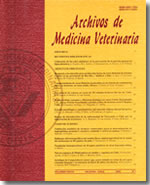Factors associated with cellular infection by the infectious pancreatic necrosis virus (IPNV)
Main Article Content
Abstract
The infectious pancreatic necrosis virus (IPNV) is one of the main causes of economic losses in salmon farms. Its temporal expression and the characteristics of its components have been described in many studies, however, the role of proteins in viral pathogenesis has not been completely determined. The aim of this review is to detail the processes that allow the establishment of a virus-cell relationship, replication and dissemination of the infection, highlighting the role of the viral components in such mechanisms and the effect of their variability on viral virulence. The molecular mechanisms that characterize Birnaviruses in relation to their replication, translation and maturity are also described. The host response and defense mechanisms against viral infection are mentioned, highlighting the importance of the non-specific immunity through stimulating the synthesis of antiviral proteins via interferon, and the importance of apoptosis as a defense mechanism that can be modulated by the virus’ proteins. Also, the role of viral and cell factors on the development of the carrier stage, which is considered one of the most important aspects in the dissemination of IPNV, is described.

